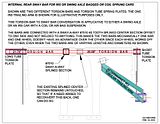Using a Torsion bar as a Sway bar
Posted: Thu Jan 23, 2014 11:58 am
OK, what are your thoughts..., on a bagged rear end car, since the torsion bars are not in use, I thought why not just put a long sway bar inside the torsion housing and connect the trailing arms for better handling. Then it hit me, to be even cheaper and just use VW torsion bars and connect them to act as a sway bar.
An Internal Rear Sway Bar for bagged or coil sprung cars

In researching this concept on Porsche and VW, I found no information on this being banned as a race car rule benders trick, when switching to coil over shocks…, giving me the impression that no one knows of it or at least written about it.
giving me the impression that no one knows of it or at least written about it.
- So for those familiar with Formula VEE racing and the way the ball joint and link pin front ends are set up on these cars, that the lower spring pack is replaced with a solid rod that connects the two front lower trailing arms together to act as a sway bar.
- Now envision the rear torsion housing of a beetle and a bar connecting one side to the other, hidden inside the housing to act as a sway bar. Again, this only works if you’re going to coil over shocks or air bagged suspension.
Now envision the rear torsion housing of a beetle and a bar connecting one side to the other, hidden inside the housing to act as a sway bar. Again, this only works if you’re going to coil over shocks or air bagged suspension.
Assembly explanation:
- Put a Short Tube torsion plate, w/a 26-9/16” long torsion bar on one side of the car.
Push this bar through the existing torsion housings splined center section.
It will stick out a few inches offset of center into the other side of the housing.
Use a 21-3/4” long torsion bar and Long Tube torsion plate on the other side.
The connection of these two bars will be a “Sway-A-Way” #7010, 40 tooth Splined Center Section that’s NOT welded to the torsion housing.
Most people don’t need an explanation, but some do. So, a swing axle Ghia turns into a corner at speed. Instead of getting body roll and wheel tuck, it gets lower to the ground and stays flat. As the outside rear wheel is pushed up in to the fenderwell, the inside rear wheel is also picked up and this forces the front inside of the body with tire down.
In the racing world simplifying to attain the same end result and losing 4 to 5lbs. of inertia rebound weight of an external sway bar along with being able to switch bar dia. sizes and mix and match to suit your ride is king. This also makes your sway bars twist and trailing arms pivot point the same, alleviating additional suspension resistance.
David / dd-ardvark
An Internal Rear Sway Bar for bagged or coil sprung cars

In researching this concept on Porsche and VW, I found no information on this being banned as a race car rule benders trick, when switching to coil over shocks…,
- So for those familiar with Formula VEE racing and the way the ball joint and link pin front ends are set up on these cars, that the lower spring pack is replaced with a solid rod that connects the two front lower trailing arms together to act as a sway bar.
-
Assembly explanation:
- Put a Short Tube torsion plate, w/a 26-9/16” long torsion bar on one side of the car.
Push this bar through the existing torsion housings splined center section.
It will stick out a few inches offset of center into the other side of the housing.
Use a 21-3/4” long torsion bar and Long Tube torsion plate on the other side.
The connection of these two bars will be a “Sway-A-Way” #7010, 40 tooth Splined Center Section that’s NOT welded to the torsion housing.
Most people don’t need an explanation, but some do. So, a swing axle Ghia turns into a corner at speed. Instead of getting body roll and wheel tuck, it gets lower to the ground and stays flat. As the outside rear wheel is pushed up in to the fenderwell, the inside rear wheel is also picked up and this forces the front inside of the body with tire down.
In the racing world simplifying to attain the same end result and losing 4 to 5lbs. of inertia rebound weight of an external sway bar along with being able to switch bar dia. sizes and mix and match to suit your ride is king. This also makes your sway bars twist and trailing arms pivot point the same, alleviating additional suspension resistance.
David / dd-ardvark